HMS Sceptre was a 64-gun third-rate ship of the line of the Royal Navy, launched on 8 June 1781 at Rotherhithe. The ship was wrecked in a hurricane on 5 November 1799 in Table Bay near the Cape of Good Hope.

HMS Agamemnon was a 64-gun third-rate ship of the line of the British Royal Navy. She saw service in the American Revolutionary War, French Revolutionary and Napoleonic Wars, and fought in many of the major naval battles of those conflicts. She is remembered as being Nelson's favourite ship, and was named after the mythical ancient Greek king Agamemnon, being the first ship of the Royal Navy to bear the name.
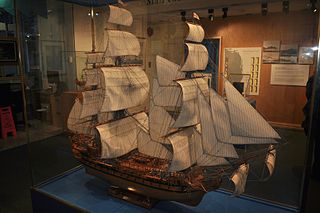
HMS Orion was a 74-gun third rate ship of the line of the British Royal Navy, launched at Deptford on 1 June 1787 to the design of the Canada class, by William Bately. She took part in all the major actions of the French Revolutionary and Napoleonic Wars under a series of distinguished captains.

HMS Berwick was a 74-gun Elizabeth-class third rate of the Royal Navy, launched at Portsmouth Dockyard on 18 April 1775, to a design by Sir Thomas Slade. She fought the French at the Battle of Ushant (1778) and the Dutch at the Battle of Dogger Bank (1781). The French captured her in the action of 8 March 1795 during the French Revolutionary Wars and she served with them with some success then and at the start of the Napoleonic Wars until the British recaptured her at the Battle of Trafalgar. Berwick sank shortly thereafter in a storm.
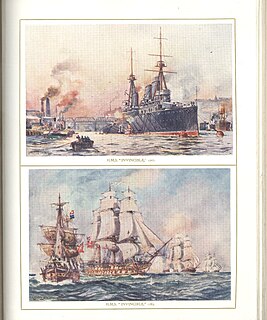
HMS Invincible was a 74-gun third-rate ship of the line of the Royal Navy, launched on 9 March 1765 at Deptford. Invincible was built during a period of peace to replace ships worn out in the recently concluded Seven Years' War. The ship went on to serve in the American War of Independence. May, 1778 under command of Capt. Anthony Parry. Fought at the battles of Cape St Vincent in 1780, and under the command of Captain Charles Saxton, the Battles of the Chesapeake in 1781 and St Kitts in 1782.

HMS Raisonnable was a 64-gun third-rate ship of the line of the Royal Navy, named after the ship of the same name captured from the French in 1758. She was built at Chatham Dockyard, launched on 10 December 1768 and commissioned on 17 November 1770 under the command of Captain Maurice Suckling, Horatio Nelson's uncle. Raisonnable was built to the same lines as HMS Ardent, and was one of the seven ships forming the Ardent class of 1761. Raisonnable was the first ship in which Nelson served.

HMS Foudroyant was an 80-gun third rate of the Royal Navy, one of only two British-built 80-gun ships of the period. Foudroyant was built in the dockyard at Plymouth Dock and launched on 31 March 1798. Foudroyant served Nelson as his flagship from 6 June 1799 until the end of June 1800.

HMS Goliath was a 74-gun third-rate ship of the line in the Royal Navy. She was built by Adam Hayes at Deptford Dockyard and launched on 19 October 1781. She was present at the Battle of Cape St Vincent, Battle of the Nile, and Battle of Copenhagen. She was broken up in 1815.
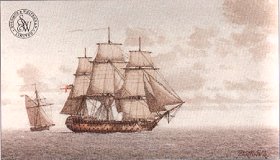
HMS Edgar was a 74-gun third-rate ship of the line of the Royal Navy, that saw service in the American Revolutionary, French Revolutionary and Napoleonic Wars. Launched in 1779, she fought in the battles of Cape St Vincent and Copenhagen, two of the major naval engagements of the wars.

HMS London was a 90-gun second-rate ship of the line of the Royal Navy, launched on 24 May 1766 at Chatham Dockyard.

HMS Fortitude was a 74-gun third-rate ship of the line of the Royal Navy, built by John Randall & Co. and launched on 23 March 1780 at Rotherhithe.

HMS Cambridge was an 80-gun third-rate ship of the line of the Royal Navy, designed by Sir Joseph Allin and built at Deptford Dockyard by Adam Hayes to the draught specified by the 1745 Establishment as amended in 1750, and launched on 21 October 1755.

HMS Egmont was a 74-gun third rate ship of the line of the Royal Navy, launched on 29 August 1768 at Deptford. She was designed by Sir Thomas Slade, and was the only ship built to her draught.

HMS Powerful was a 74-gun third rate ship of the line of the Royal Navy. She took part in the defeat of a Dutch fleet in the Battle of Camperdown in 1797, the capture of a French privateer in the action of 9 July 1806, in operations against the Dutch in the East Indies during the raids on Batavia and Griessie in 1806 and 1807, and finally in the Walcheren Campaign during 1809.
HMS Bedford was a Royal Navy 74-gun third rate. This ship of the line was launched on 27 October 1775 at Woolwich.
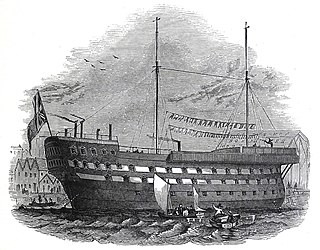
HMS Warrior was a 74-gun Alfred-class third-rate ship of the line of the Royal Navy, launched on 18 October 1781 at Portsmouth.
HMS Ruby was a 64-gun third-rate ship of the line of the Royal Navy, launched on 26 November 1776 at Woolwich. She was converted to serve as a receiving ship in 1813 and was broken up in 1821.
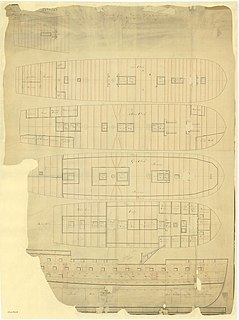
HMS Monmouth was a 64-gun third rate ship of the line of the Royal Navy, launched on 23 April 1796 at Rotherhithe. She had been designed and laid down for the East India Company, but the Navy purchased her after the start of the French Revolutionary War. She served at the Battle of Camperdown and during the Napoleonic Wars. Hulked in 1815, she was broken up in 1834.

Bienfaisant was a 64-gun ship of the line of the French Navy, launched in 1754.

Fénix was an 80-gun ship of the line (navio) of the Spanish Navy, built by Pedro de Torres at Havana in accordance with the system laid down by Antonio Gaztaneta launched in 1749. In 1759, she was sent to bring the new king, Carlos III, from Naples to Barcelona. When Spain entered the American Revolutionary War in June 1779, Fénix set sail for the English Channel where she was to join a Franco-Spanish fleet of more than 60 ships of the line under Lieutenant General Luis de Córdova y Córdova. The Armada of 1779 was an invasion force of 40,000 troops with orders to capture the British naval base at Portsmouth.

















